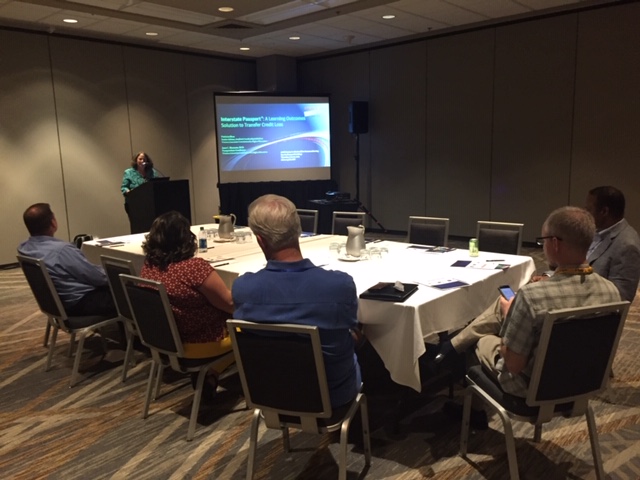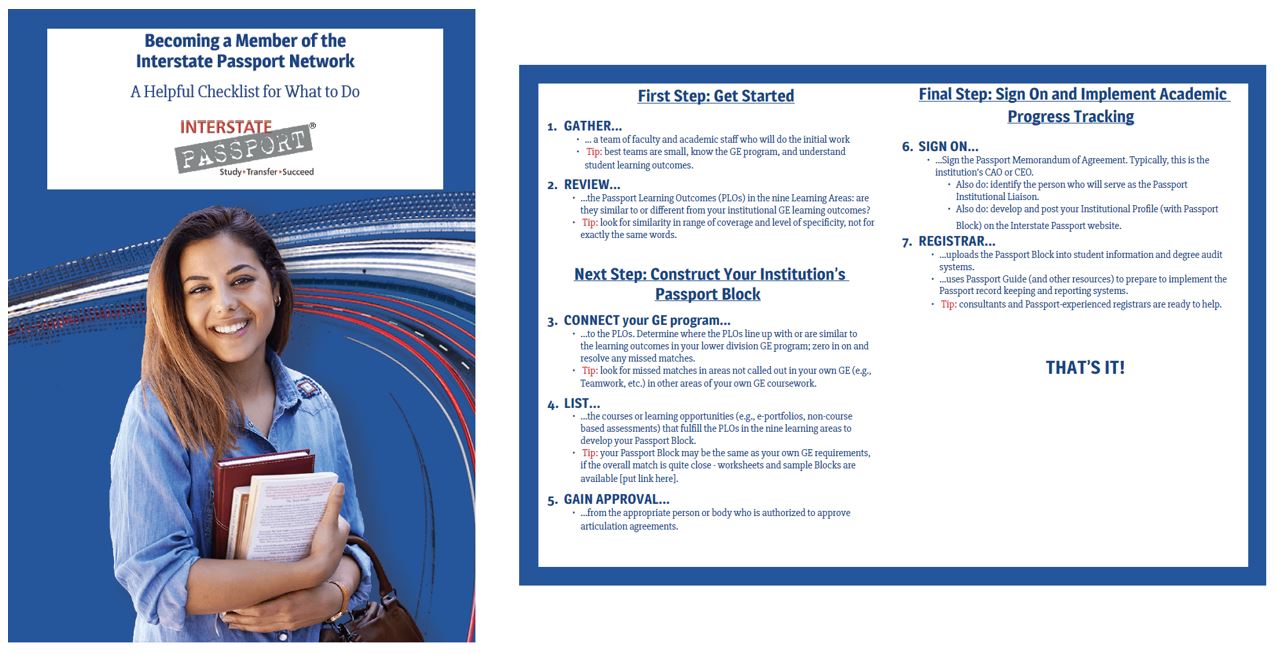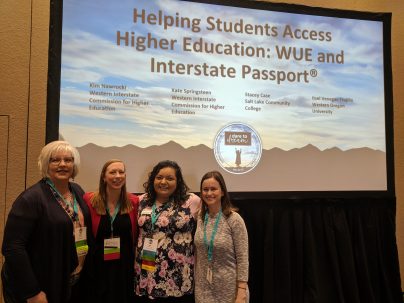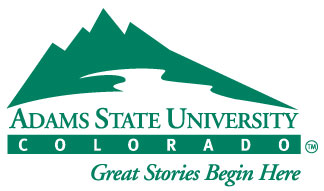By Laura Vidler, associate dean for administration and professor of Spanish in the College of Arts & Sciences at the University of South Dakota

Teamwork is collaborating towards a common purpose through shared responsibility and mutual accountability, while maintaining healthy relationships. Value Systems are a coherent set of ethical standards adopted and/or evolved by a team as a standard to guide its behavior. Teamwork and value systems may be embedded in any of the content areas or across multiple courses in the institution’s Passport Block.
It takes a truly intentional effort to develop a culture of teamwork and value systems within an organization. Perhaps that is why, after teaching at the United States Military Academy (West Point) for 12 years as a civilian professor, the words “may be” above sound really strange—so strange that I bolded and italicized them. There is no place in the four pillars of the West Point curriculum (academic, military, physical, character), or anywhere on the garrison, where value systems and teamwork are not embedded. Value systems, as standard guides to behavior, underlie everything that teams and organizations do. They are prerequisites to, and are shaped by, teamwork. It should not surprise anyone, then, that teamwork is an integral part of the U.S. Army’s value system.
New cadets at West Point begin their lessons in teamwork, and in the West Point and U.S. Army value systems, on the very first day. Reception Day (R-Day for short) is the day of their arrival, the day they bid farewell to their families, and the day that they begin Cadet Basic Training (CBT, also known as “Beast Barracks”). Expectations are set instantly—new cadets are expected to follow orders and are permitted only four responses to direct address: “Yes, Sir/Ma’am/Sergeant,” “No, Sir/Ma’am/Sergeant,” “I don’t know, Sir/Ma’am/Sergeant,” or “No excuse, Sir/Ma’am/Sergeant.” Duty and Loyalty to the team—their cadet company—is paramount. West Point and the U.S. Army ensure that new cadets understand this through the application process, the signing of commitment papers, and their oath to protect and defend the Constitution. Once they arrive, new cadets demonstrate teamwork by trusting and following their leaders, by pulling their weight in group tasks, and by behaving in ways that are consistent with the cadet/U.S. Army code of conduct. Upper-class cadets teach new cadets by modeling appropriate behavior and through the testing of “plebe knowledge”—the memorization of regulations, history, principles, trivia, and traditional oddities that build the camaraderie and unit cohesion for which the “Long Gray Line” is famous. Even old grads can still recite “How is the Cow?” (Really. Google it.)
As yearlings (sophomores), cadets begin to apply the concepts of teamwork and values as leaders. Cadets are paired with a single plebe and become responsible for his or her success. The yearling is known as the “team leader,” even though the “team” is only two people. The yearling receives a grade (on an A-F scale, just like an academic class) based on how the team functions. Their “common purpose” is the success of the plebe. The two team members share responsibility—the plebe must pull their weight and do their work, and the yearling must ensure that they have all the skills and knowledge necessary to do it. If the plebe is struggling with the Army Physical Fitness Test, then the yearling will wake them up for early runs around post. If the plebe is struggling in chemistry, the yearling ensures they get to Additional Instruction (office hours), and so on. They are mutually accountable to each other, as in a mentor-protégé relationship. They both know that the team’s overall success depends on their mutual commitment to each other.
On a broader scale, USMA intentionally organizes teams in both pragmatic and symbolic ways. For example, the living and work-unit arrangements are designed to foster team and unit cohesion. The United States Corps of Cadets is organized as a brigade with four regiments. There are three battalions in each regiment, each with three companies. So, you might be in company F-4 (4th regiment, F company). They are known as the Frogs (to distinguish themselves from companies F-1, F-2, and F-3). They have a Frog logo, a Frog mascot, Frog patches, and Frog traditions. Companies, battalions, and regiments go through training together, eat together, stand in formation together, hold each other accountable, and compete as a unit. At the end of the year, outstanding companies are awarded with ribbons for their successes in academic, military, physical, and character endeavors. At the end of the four-year, 47-month “experience” (as the leadership likes to call it), every “firstie” (senior) dons a class ring—a concept, by the way, invented by West Point. For about the last decade or so, the rings have included metal melted from the rings of former West Point graduates, usually from an anniversary class (say, 50 years ago).
Teamwork is also embedded in the academic program. Group work is strongly emphasized at West Point. For many years, I was responsible for leading the capstone projects for Spanish and Latin American Studies majors. Cadets were required to complete both an individual written research project and a group briefing (presentation). The group presentations were held on Projects Day—a campus-wide celebration of undergraduate research. Frequently we hosted high-level guests on that day—general officers from foreign armies, members of Congress, civilian executives, U.S. Army and other U.S. government officials, and successful alumni. Teams are expected to jointly agree on a research question. Each cadet researches and writes a paper about a substantive aspect of that question, and then the group brings all of that research to bear in a major statement on the issue. It is quite a challenge for them all to work together towards this goal. However, this kind of assignment reflects the focus on both individual and collective effort that is required of Army officers in their own units as well as in joint-operations.
West Point faculty members, whether military or civilian, are also expected to uphold and work within these values and methods. For example, failing a course at USMA is pretty tough because the underlying value system places the responsibility for cadet success on the leader—in this case, the faculty member. Cadets are not allowed to graduate having failed a class. When they do fail, they face an Academic Board. If the Board does not “separate” (expel) them, the cadet must repeat the course, usually in the summer. During my tenure, at least in my department, the department head reviewed my grades before I was authorized to submit them. Any Fs required documentation of my efforts to support the cadet. Did I provide sufficient and timely feedback? Did I require the cadet to come in for Additional Instruction? Did I contact the cadet’s tactical officer to inform them of the cadet’s low performance? What was the course average? The idea behind this approach is that we succeed or fail together. This perspective is so deeply embedded into the organization that when two of my former cadets were killed in action in Afghanistan six weeks apart, my first reaction was to consider what I was doing in the Spanish program that failed to prepare them for combat. Of course, I was overreacting in grief and shock. Later, when I learned more of their stories, I saw everything we did right. First Lieutenant Daren Hidalgo was killed by an IED only two weeks after being previously wounded. Doctors had recommended sending him home, but he refused to leave his team. He was in that battle that day because he embraced both USMA’s lessons in teamwork and the Army’s shared values.
I have since transitioned to a civilian university. Although the intensity of West Point’s emphasis on teamwork is not viewed with the same urgency in this setting, I frequently reflect on the ways in which a more systematic approach to teamwork and values can significantly improve student learning and preparation for career success. The intentional focus on teamwork and value systems, both at West Point and throughout the Interstate Passport, teaches students how to enable groups to accomplish value-based goals. At the University of South Dakota, the courses we’ve selected for our Teamwork/Value Systems Passport block incorporate both group-work and ethical components. General Biology, for example, requires group lab work as well as the consideration of the ethical treatment of living tissue/organisms. Introduction to Acting requires collaboration between student-actors and an agreed-upon system of working together respectfully. Furthermore, South Dakota as a Passport participant has embraced the Teamwork and Value Systems goal at all of our state institutions. Teamwork is also one of eleven cross-curricular skills embedded into our general education framework. We have even embraced teamwork and value systems in administration. At USD, we’ve attempted to foster a culture of teamwork through a clear re-articulation of our values, especially at the College level. We collaborate on a daily basis to make the University better through our system of shared governance. My hope is that by explicitly acknowledging both teamwork and value systems throughout the curriculum and the organization, we will teach and model these skills more openly and intentionally.
Laura L. Vidler, Ph.D., is associate dean for administration and professor of Spanish in the College of Arts & Sciences at the University of South Dakota. She was formerly associate dean of the International Intellectual Development Division and program director of Spanish at the United States Military Academy, West Point. She is also the human cultures goal team chair for Interstate Passport.








